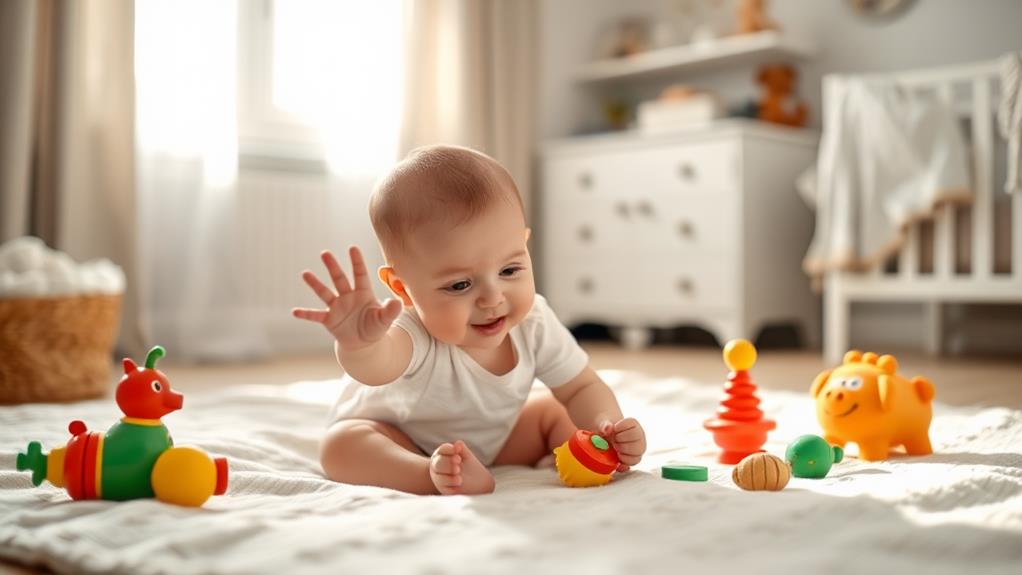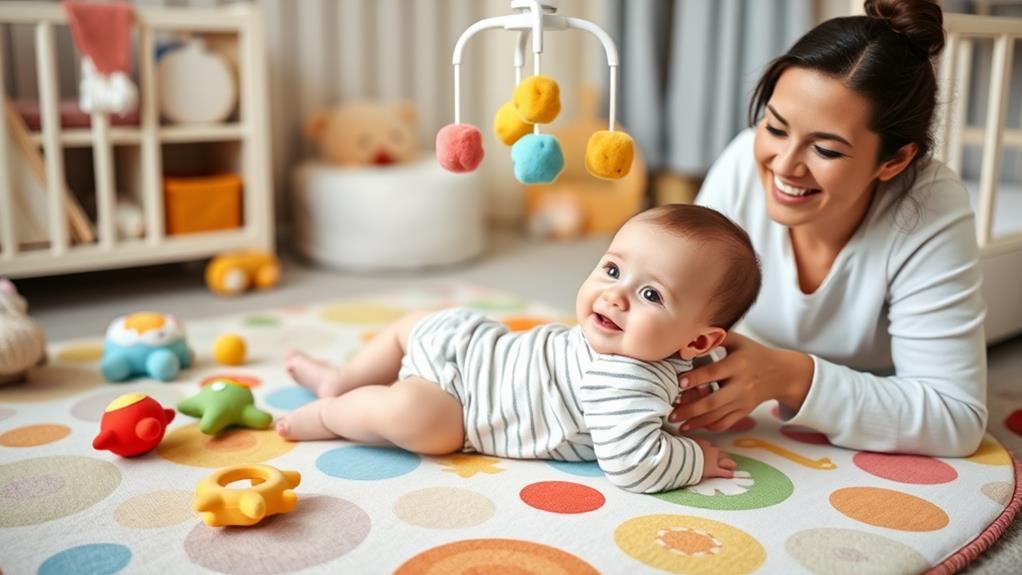At four months, your baby is hitting several key milestones that signal important growth in physical, cognitive, and emotional areas. You might notice them lifting their head and chest more confidently during tummy time, or their fascination with the world around them. As they begin to express themselves through cooing and smiling, you'll see their communication skills start to emerge. Understanding these developments can help you support their progress effectively, but there's more to explore about how you can actively engage with your baby during this crucial period.
Physical Development Milestones

At four months old, your baby's physical development is blossoming as they reach exciting milestones. You might notice them starting to push up when lying on their tummy, lifting their head and chest off the ground. This newfound strength is a great sign that they're building muscle and coordination.
Around this age, many babies can also roll from tummy to back. This skill not only surprises you but also makes playtime more fun! You might find your little one wiggling and squirming as they explore their surroundings.
Grasping objects becomes more refined, too. Your baby will likely reach for toys, bringing them closer to their mouth for exploration. This is a crucial part of their sensory development.
As they continue to grow, you may observe improved hand-eye coordination. Your baby might be able to swipe at hanging toys, showing increasing control over their movements.
Cognitive Development Progress
By four months old, your baby's cognitive development is rapidly advancing, showcasing their growing curiosity about the world. At this stage, your little one is starting to notice patterns and recognize familiar faces. You might see them responding more to sounds, like when you call their name or play their favorite song. This is a sign that they're beginning to understand the connection between actions and outcomes.
Your baby may also show interest in toys, exploring them by grabbing, shaking, or even looking closely at them. This exploration helps strengthen their problem-solving skills. When they reach for an object, they're not just playing; they're learning about cause and effect.
Additionally, your baby's memory is improving, allowing them to remember things longer. You'll notice them tracking objects with their eyes, which is a great sign of their developing attention span. Engaging in simple games, like peek-a-boo, can enhance their cognitive skills and foster their understanding of object permanence.
Encouraging these skills through interaction and play can greatly benefit your baby's cognitive growth. So, talk, sing, and play with your baby; it's not just fun, it's helping their mind develop!
Emotional and Social Growth

As your baby's cognitive skills flourish, you'll also witness significant strides in their emotional and social growth. Around four months, your little one starts to develop a deeper connection with you and others in their environment. They may smile in response to your smile, showing that they're beginning to understand social interactions.
You might notice your baby becoming more expressive, using a range of facial expressions to communicate their feelings. They may laugh or squeal with joy when they see familiar faces, indicating their growing attachment. This is a crucial time for bonding, as your baby learns to recognize and respond to emotions in others.
Your presence is essential; when you hold or cuddle them, they feel safe and loved. They may also engage in "social play" by cooing and making eye contact, which strengthens your emotional connection.
As they explore their world, they'll begin to experience different emotions, like excitement or frustration, while interacting with toys or people. This exploration helps them learn how to express themselves and understand social cues, laying the groundwork for future relationships.
Encouraging these moments of interaction will nurture their emotional and social development beautifully!
Communication Skills at 4 Months
Communication skills blossom significantly around four months, marking a fascinating phase in your baby's development. At this age, you'll notice your little one becoming more vocal, experimenting with sounds like cooing and gurgling. These sounds aren't just random; they're your baby's way of exploring their voice and engaging with the world around them.
You might find that your baby responds to your voice, turning their head towards you when you speak. This indicates they're starting to recognize and understand the rhythm of conversation. When you talk to them, they may even try to mimic sounds, which is an essential step in language development.
Don't be surprised if your baby becomes more expressive with their emotions, too. They might smile or frown in response to your tone, showing that they're picking up on non-verbal cues.
Engaging in back-and-forth interactions, like babbling to one another, isn't only fun but also reinforces these communication skills.
Encouraging this development is simple—keep talking, singing, and reading to your baby. Your interactions will help build a strong foundation for their future language abilities, so enjoy this special time of discovery together!
Sleep Patterns and Changes

At four months old, your baby's sleep patterns are likely starting to stabilize, which can be a welcome change for both of you. You might notice that your little one is gradually sleeping for longer stretches at night, often totaling between 10 to 12 hours. This improvement can mean more restful nights for you, too!
During this time, your baby may also start to develop a more predictable nap schedule. Expect to see about two to three naps during the day, each lasting anywhere from 30 minutes to two hours.
It's essential to create a calming bedtime routine to help signal to your baby that it's time to wind down. Incorporating activities like gentle rocking, soft singing, or reading a short story can work wonders.
Keep in mind that every baby is unique, so sleep patterns can vary. Some babies may still wake up during the night, which is perfectly normal.
If your baby struggles to settle down or seems restless, you can try adjusting the environment by dimming lights, reducing noise, or ensuring they're comfortable.
With time, patience, and a little trial and error, you'll find a pattern that works for both of you!
Feeding and Nutrition Tips
Feeding your four-month-old baby is an exciting time, as you might start introducing solid foods alongside their usual breast milk or formula.
Before you dive in, make sure to consult with your pediatrician, as they can guide you on the right timing and suitable foods.
When you begin, start with single-grain cereals, like rice or oatmeal, mixed with breast milk or formula to create a smooth consistency.
As you introduce solids, be patient and watch for signs of readiness. Your baby may show interest by leaning forward or opening their mouth when food is near, which are good indicators that they're ready to try new flavors.
It's essential to introduce one new food at a time, waiting a few days before adding another. This helps you identify any potential allergies.
Activities to Encourage Development

As you introduce solid foods to your four-month-old, it's also a great time to engage in activities that promote their overall development. Tummy time is essential, so make sure to give your baby plenty of chances to strengthen their neck and shoulder muscles. You can place colorful toys just out of reach to encourage them to reach and roll.
Reading to your baby helps with language development, so choose vibrant picture books and engage them with your voice. Pointing out objects and naming them can further stimulate their cognitive skills.
Don't forget to incorporate music! Singing or playing soft tunes can enhance their auditory senses, making them more aware of different sounds.
Interactive play is also vital. Use soft toys or rattles to encourage grasping and shaking, which helps improve fine motor skills. Remember to make eye contact and smile, as this builds emotional connections and social skills.




